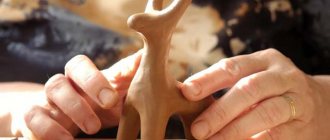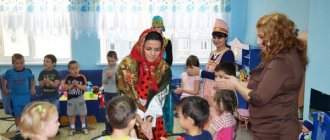Consultation “Open classes as an effective form of methodological work”
Open lesson is one of the effective forms
organization of methodological work in preschool educational institutions
Increasing the level of skill of teachers is a priority area of methodological work, which occupies a special place in the management system of a preschool institution and represents an important link in the holistic system of advanced training of teaching staff. A constant connection between the content of methodological work and the results of teachers’ work ensures a continuous process of improving the professional skills of each educator.
Therefore, preschool educational institutions use new, effective forms of work that contribute to the activation of the teacher’s personality and the development of his creative personality.
Open classes are one of the effective forms of organizing methodological work in preschool educational institutions.
In educational practice, sometimes they do not distinguish between open and regular classes, and do not represent the features of preparing and conducting open classes.
An open lesson, unlike ordinary ones, is a specially prepared form of organizing methodological work, during which the main directions of the educational process of a preschool institution are implemented.
In an open lesson, the teacher shows his colleagues his positive or innovative experience in implementing a methodological idea, using a specific method or teaching method.
In this sense, an open lesson has a methodological goal, which contains the main points of what the teacher can show to those attending this lesson.
The purposes of open viewings are varied. Before the start of the lesson, the teacher first introduces the teachers to the lesson.
| I | Group characteristics: | - age characteristics of children; -the degree of children’s assimilation of the program; - real educational opportunities for children. |
| II | A story about the project for the upcoming lesson: | -place of the lesson in the topic, section, etc.; -goals, objectives of the lesson; -characteristics of educational content -material; -lesson structure. |
| III | Justification for the open lesson project | -relevance of the chosen topic of the lesson; - connection between the topic of the lesson and the methodological a problem, a topic of self-education that the teacher is working on. |
| IV | Open lesson plan | 1. The topic of the lesson and the “name” of the lesson. 2. Formulated methodological innovations proposed in the upcoming lesson. 3. Brief structural summary of the most interesting element of the lesson: supporting summary; samples of didactic materials (didactic games, handouts, sample, etc.); memos, booklets; list of used literature. |
There are a number of requirements for preparing and conducting open classes with preschool children.
1. Open classes are conducted by teachers who have a high level of scientific and methodological training and ensure high efficiency of the educational process;
2. An open lesson is a source of innovative experience and includes current problems of methodological science in the field of preschool pedagogy and psychology;
3. Open classes must be novel;
Novelty may relate to the content of didactic material or methods of studying it.
Showing classes in which methods that are widely used in practice are implemented does not contribute to the professional growth of other teachers.
In methodological work with young teachers, this limitation does not always need to be taken into account, since for them traditional, well-known methods are of a certain interest.
4. An open lesson as a form of organizing the educational process may itself contain a new, special structure;
5. An open lesson reflects the solution to a methodological problem, a topic of self-education, on which the teacher is working;
Its individual methodological theme is associated with the general methodological problem of the preschool educational institution team; it is this indicator within the framework of the lesson that contributes to the implementation of a systematic approach to the organization of scientific and methodological work in the teaching staff;
6. An open lesson shows (proves) the advantages or high efficiency of innovation or tradition in organizing children’s activities, therefore the teacher showing the open lesson chooses a topic whose content allows this to be done;
7. The teacher selects the topic of an open lesson in advance and prepares theoretical material, visuals, multimedia, classroom space, equipment, etc.;
8. When conducting an open lesson, all requirements for the educational process are met, the lesson is conducted under normal conditions, with a generally accepted duration, etc.;
9. An open lesson should not harm the system of knowledge, abilities and skills of children, their values.
Children should gain as much knowledge as they would have learned by studying this topic without anyone attending; it is also unacceptable to explain only that part of the lesson topic that allows you to most clearly demonstrate a new methodological technique, leaving the next part for another lesson or other activity.
10. A workplace must be prepared for visitors, which is located behind the children’s backs so that visitors do not distract their attention;
The visitor cannot be seated next to the child, on the side. The number of visitors to an open lesson cannot be unlimited. For example, in a group of 20 children invited to an open lesson, there are 10-15 teachers. Observations show that the attendance of classes by at least one stranger creates discomfort for both the teacher and the children, and therefore, it is now widely practiced to study the experience of teachers using video recordings of their professional activities.
11. Open classes and their content should not contradict the programs under which the teacher and the preschool educational institution as a whole work.
12. It is unacceptable to “rehearse” an open lesson with the same group or subgroup of children;
The day before, it is recommended to inform children and parents about an open lesson; this will prepare children for the situation when there will be visitors to the lesson;
13. Open viewings of classes and other activities are carried out in accordance with the methodological work plan of the preschool educational institution and teachers must have sufficient time to prepare it;
Practice shows that it is impossible to conduct several open classes in one group on the same day; it is also undesirable to conduct such classes in the same group within a month. This is explained by the great psychological stress that children and teachers experience.
14. When preparing an open lesson, the triune didactic goal must be taken into account: teaching, educating, developing and, additionally, motivational;
When preparing an open lesson, the teacher must take into account three types of motivation:
-social – creating a situation of success, using praise, encouragement, the child’s right to make mistakes;
-substantive – the formation of experience in collective and creative activity, the organization of individual work with children, the creation of a problem situation;
-pragmatic – to increase children’s attention to this type of activity, the development of cognitive interest in preparing the future student (FEMP, speech development, children’s experimentation, artistic activities, etc.).
15. To actualize children’s cognitive interest during an open lesson, a teacher can use a variety of methodological techniques:
- clear organization and planning of all parts of the lesson;
-intriguing beginning;
- taking into account the individual characteristics of children;
- friendly tone, gestures, facial expressions that are attractive to you;
- motives for activity.
Analysis of an open lesson with the participation of those who attended the lesson is not mandatory. If the methodological work plan of the preschool educational institution plans to analyze it, then first the floor is given to the teacher - the author of the lesson. It recalls the methodological goal of the lesson and gives a brief description of the work to achieve it. In contrast to the analysis of classes attended for the purpose of control, a discussion of open viewing involves consulting those present, reflection, active discussion, exchange of opinions, discussions, disputes, etc. .
Notes of all open classes are prepared and stored in the methodological office.
When preparing for an open lesson, a teacher needs to predict the expected results and expected risks.
Methodologically competent organization of open screenings of children's activities, including open classes, contributes to the continuous improvement of teacher qualifications in preschool educational institutions, comprehension of advanced pedagogical experience at a higher theoretical and practical level, and improves professional skills.
Open display of gcd
Educator: Olga Aleksandrovna Burganova Open display of NOD - 09/30/2016. NGO “Artistic and Aesthetic Development” Direction: Visual activity. Drawing. Targets:
demonstrates the ability to hear others, masters basic movements, can control and manage his movements, masters methods of activity, shows initiative and independence in various types of activities.
Subject. "Hello, it's me!"
Target:
practice sketching skills; consolidate the ability to convey characteristic features, specific features, and reflect them in a drawing; to cultivate interest in the work of artists, respect for their work, creative self-realization; promote the formation of a positive attitude in children.
Material
: reproductions of paintings: I. Repin “Nadya Repina, the artist’s daughter”, B. Kustodiev “Portrait of I. Kustodieva with the dog Shumka”, A. Venetsianov “Here are Father’s dinner”, I. Glazunov “Verochka”, A. Shilov “ Mashenka Shilova,” group photo; pencils; 1/2 of a landscape sheet, a sheet of A2 paper, a diagram of a step-by-step drawing of a person’s face, samples of a teacher - portraits of a girl and a boy.
Preliminary work
. Introducing children to portraiture, its features, and the fact that artists paint portraits using different materials. Reading fiction about professions.
Design of the spatial subject-developmental environment of GCD in the group:
-exhibition of reproductions of children's portraits,
-fairy-tale character – artist (surprise moment).
Literature:
1. Basic exemplary general education program “From birth to school”, ed. N. E. Veraksy, T. S. Komarova, M. A. Vasilyeva // 2021
2.Comprehensive classes in visual arts / preparatory group, ed.-comp. O.V. Pavlova. – Volgograd: Teacher, 2021.- 191 p.
3. Visual activities in kindergarten (6-7 years old), preparatory group of the Federal State Educational Standard. Komarova T.S.
Progress of the lesson
.
1. Organizational moment.
1.1.Formation of a positive emotional attitude.
A minute of entry into the day “Friend”
“All the children gathered in a circle, I am your friend, and you are my friend. Let’s hold hands together and smile at each other.”
Greeting guests (preschool teachers).
2. Introduction to the topic.
— Guys, today we have a very interesting topic: “Hello, it’s me!” (Shows a picture of the artist). Listen to the riddle and guess who it is.
“I have a pencil, Multi-colored gouache, Watercolor, palette, brush And a thick sheet of paper, And also a tripod easel,
Who am I……..(artist)!”
- That's right, artist!
—Who is an artist? (This is the person who creates the paintings).
— Who remembers which artist we met recently? (Levitan).
— What did he depict in his paintings? (Nature, autumn).
1.3. Cognitive activity.
— Pay attention to this exhibition of paintings. Questions:
— What genre of painting do you think these paintings belong to? (Portrait.)
- Who is depicted on them? (Children.)
— When depicting children, artists show not only what children look like. What else did they want to show? (The time when we lived, the mood.)
— What material do artists use for painting? (Children's answers).
(The teacher shows a general photo of the group).
-Who do we see in this photo? Is it possible to draw a group portrait with all the children in it? How can you draw this? (Children's assumptions).
(Draw everyone on a large sheet, everyone draws themselves or a friend, but it’s awkward for everyone to draw at once. You can draw on separate sheets, cut them out and paste them onto a large sheet.)
-Guys, I have a flower! What is it called? (Demonstrates a seven-flowered flower. Children give answers). You know - he's magical! Now he will help us turn into artists! (Playing up the situation of transformation).
Phys. minute “The wind blows..”
Creative practical activity. Drawing a self-portrait with pencils.
A). Analysis of a teacher's sample - portraits of a girl and a boy, examination of a step-by-step scheme for drawing a portrait, demonstration of working techniques.
b). Children draw self-portraits. (The teacher conducts ongoing individual and frontal instruction).
V). After drawing, they cut out the portrait and paste it onto a common sheet of paper. On the sheet, large portraits are placed below, and small ones above. Children look at the general view of the picture. Everyone drew themselves; when all the drawings were combined, a portrait of the group was obtained.
Reflection.
“Do you think one person could have painted this portrait faster? How do you picture yourself? Happy or sad? Did you like this portrait?”
Author: Deputy Head of Internal Affairs, S.M. Bidova, 29.03. 2016
Open viewings of direct educational activities with students play an important role in improving professional competencies in the context of the introduction of the Federal State Educational Standard for Education.
The activity of the teacher during direct educational activities with students makes it possible to assess the level of professionalism in creating psychological and pedagogical conditions in accordance with the new requirements for them. Colleagues have the opportunity to see what professional competencies ensure the implementation of the Federal State Educational Standard for Education in practice. This is certainly a positive experience that you can implement in your work. Only thoughtful, prepared open screenings build teachers’ self-confidence, ensure the effectiveness of educational activities, and create a social situation for the child’s development with his needs and interests.
The effectiveness of this form of work largely depends on its correct preliminary preparation.
There are a number of requirements for preparing and conducting open screenings of direct educational activities with preschool children.
In this case, open viewing of direct educational activities differs from ordinary direct educational activities with children in that it is a specially prepared form of organizing methodological work. So, in the process of preparing open screenings on the speech development of children in MBDOU No. 29 “Baby”, the basic requirements for psychological and pedagogical conditions were implemented as part of the introduction of the Federal State Educational Standard for Preschool Education.
At open screenings of direct educational activities on speech development, teachers demonstrated to their colleagues their positive or innovative experience in creating psychological and pedagogical conditions for development:
- verbal communication with adults and peers;
- enriching children's speech; encouraging children's speech creativity;
- development of correct speech in children; children's speech thinking;
- planning and regulating functions of speech; preparing children for reading and writing.
The teachers showed methodological ideas and applied specific techniques and methods for developing speech in children. Typically, an open demonstration was conducted by teachers with a high level of professional competence and high performance in the educational process. This time, an open demonstration of direct educational activities with children was carried out by young teachers who do not have much positive experience; they had the opportunity to conduct self-analysis and analysis of colleagues, compare and determine for themselves specific tasks for self-education to increase the level of professional competence, taking into account the requirements of the Federal State Educational Standard for Education. .
In the context of the introduction of the Federal State Educational Standard for Preschool Education, we understand that it is necessary to conduct an analysis of staffing, a comprehensive assessment of the professional activities of teaching staff in preschool educational institutions, to identify the needs and problems of each teacher in order to provide him with effective methodological support.
In my firm conviction, prepared, taking into account the requirements of the Federal State Educational Standard for Education, an open review of direct educational activities with children, in which an activity-based approach and integration of educational areas are implemented, will certainly help improve the professional competencies of other teachers.
In methodological work, open viewing is of some interest not only for young teachers.
As a form of organizing the educational process, open display of directly educational activities today contains a new, special structure. It may reflect the solution to a methodological problem, a self-education topic that the teacher is working on, or a preschool educational institution.
In preparation for open viewing, the teacher must prepare theoretical and visual material, multimedia, equipment, organize the educational space, think through health-saving and gaming technologies that include visual modeling and other innovations, etc.
Clearly, open screenings create certain inconveniences for both the teacher and the children. In this regard, in the future, we plan to practice studying the experience of teachers using video recordings of their professional activities. This is explained by the great psychological stress that children and teachers experience.
Open demonstrations of direct educational activities are held in accordance with the annual plan of methodological work of the preschool educational institution.
The purpose of open screenings on speech development is to increase the level of professional competencies taking into account the requirements of the Federal State Educational Standard for Education (to create psychological and pedagogical conditions for the speech development of children), to conduct self-analysis to create these conditions. In the course of direct educational activities, which are based on an activity-based approach, children must acquire knowledge taking into account the integration of five educational areas. It is unacceptable to explain only that part of the topic that allows you to most clearly demonstrate a new methodological technique, leaving other aspects for the next event or transferring them to another activity. An open display of direct educational activities must correspond to the educational program in which the teacher and the preschool educational institution as a whole works. Notes of all open viewings are prepared and stored in the methodological office.
Analysis of open views on speech development made it possible to assess the manifestations of professional competencies of teaching staff, taking into account the requirements of the Federal State Educational Standard for Educational Education. Most teachers have developed professional competencies to create psychological and pedagogical conditions, i.e., the guidelines are well formed and work. There is a category of teachers whose guidelines are not only well formed and work, but can also teach others. Unfortunately, there are teachers for whom a guideline has been formed, but it is not always manifested in their teaching activities.
When preparing for an open demonstration of directly educational activities, the teacher predicts the expected results and calculates the pedagogical risks. Thus, a methodologically competent, organized open review of direct educational activities helps to increase the professional competence of a teacher in creating psychological and pedagogical conditions in accordance with the requirements of the Federal State Educational Standard for Educational Education. In order to provide information to parents and the professional community, all notes from open screenings with photo materials are posted on the website of MBDOU No. 29 “Baby”. Teachers who have prepared a high level of open screenings are awarded diplomas and certificates of honor and are submitted to professional competitions.
CHILDHOOD GUIDE
Over the course of my professional career, I have watched hundreds of open classes. As you know, mistakes are always easier to see from the outside. Here are some mistakes you can avoid:
1. Before conducting an open lesson, “scroll” it in detail in your head . Pay special attention to the connections between tasks (what will I say about the next task, where will the children stand, where to remove this or that attribute, etc.).
2. Think through all the questions. Don't ask questions like: "What do you think about this picture?" (this is an example from life, as one teacher asked at the very beginning of the lesson, when introducing the children to the painting). All children's answers are accepted! You can’t say: “Vasya, you said it wrong.” You need to ask other children: “Who thinks differently?”
3. Despite the fact that now all classes are held more democratically (it is not necessary to sit at tables, raise your hand when answering, etc.), keep the whole situation under control, especially discipline ! I witnessed such a situation when children, in a creative impulse, began to shout over each other, jumping up from their seats to answer the teacher’s question. The situation has become uncontrollable! The teacher had to shut up, wait until they calmed down, and then continue the lesson. She did not dare to reprimand the children in an open lesson. As a result, the pace of the lesson was completely disrupted and the overall impression of a seemingly good creative lesson turned out to be not very positive. This does not mean that a remark should have been made. This means that we need to anticipate all unforeseen and problematic issues and correct the situation on the fly. This is “aerobatics” in professional activities.
4. About the tempo rhythm. This is an important component of an open lesson. It must be carried out at the same pace, without delaying time. The pace of the lesson is slowed down by excessive verbalization (overload with verbal material), and sometimes by independent productive activity of children in the practical part of the lesson (long drawing, modeling, design, completing some task). It is also difficult to “keep” the tempo in speech development classes (this applies to teaching retelling, analyzing words, teaching literacy, etc.). Therefore, think about whether it is worth taking this or that methodological technique specifically for an open lesson.
For example, when playing the “Color” lotto game (the rules are as follows: the teacher shows his card, and the children find the same one), the teacher can ask for the first time what is shown on the card, what color it is, who has this card. But then, in order not to prolong the lesson, you can simply ask: “Who has such a card?”
5. Maintain the storyline until the end of the lesson. If at the beginning of the lesson you “went into the forest with the children,” then do not forget to “leave the forest” at the end of the lesson.
6. You have the right to change the lesson , adjust it “on the fly”, i.e. in the process of conducting (for example, not to carry out some task, but to play a game; to remove some part of the lesson due to lack of time, etc.). But you must finish the lesson with a reflective part.
If they make a remark to you when analyzing a lesson (inspectors or colleagues, for example, say that not all tasks have been solved), then you must state the reason for such an adjustment and say that this was a pedagogically justified situation and you will definitely implement this task at other scheduled moments or at the next lesson. I repeat, you have the right to any sudden adjustment of the GCD! You just need to be able to explain your actions.
Dear Colleagues! If you have questions about the topic of the article or have difficulties in working in this area, then write in the comments . I'll definitely help.
Golovina Bela Gennadievna, site administrator, candidate of pedagogical sciences.
The summary of an individual open lesson for parents of the Ministry of Emergency Situations warns: water does not forgive mistakes! How to develop a developmental lesson How to correctly develop a synopsis of direct educational activities according to the Federal State Educational Standard >



